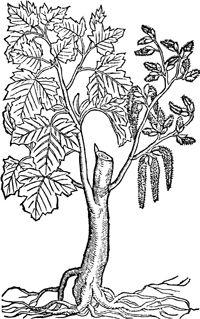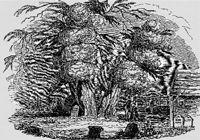Witchcraft Medicine: Healing Arts, Shamanic Practices, and Forbidden Plants (43 page)
Read Witchcraft Medicine: Healing Arts, Shamanic Practices, and Forbidden Plants Online
Authors: Claudia Müller-Ebeling,Christian Rätsch,Ph.D. Wolf-Dieter Storl


In antiquity the white poplar (
Populus alba
L.) was sacred to Hercules. Dioscorides mentioned that a salve made from the leaves and honey would alleviate infirmity. The salicine found in the bark was considered medicinal up through the modern era. (Woodcut from Gerard,
The Herbal,
1633.)
PLANT PRODUCTS AND THEIR ASSUMED PLANT SPECIES (CONTINUED)
| Stramonii | Datura stramonium |
Stomach seeds | Papaver somniferum |
Tobacco | 1. |
2. | |
Thebaicum | opium |
Tormentill | Potentilla erecta |
(syn. | |
Verbene | Verbena officinalis |
Water-Merck | 1. |
2. | |
Wolfwort, Wolf-root | 1. |
2. | |
3. | |
4. | |
Wolf’s milk | 1. |
2. | |
Yew | Taxus baccata |
ANIMAL PRODUCTS
Badger lard, bat blood, bird blood, cat brain, child blood, child fat, fox lard, hoopoe blood, infant blood, menstrual blood, milk, owl blood, screech owl blood, Spanish fly
(Lytta vesicatoria),
toad poison
(Bufo bufo),
wolf blood, wolf fat, wolf lard, vulture fat
OTHER
Bitumen, Communion wafers, oil, rust, salt, soot, wine

Ancient yews often grow in cemeteries. But they were not planted by the cemetery groundskeepers; the Celtic druids planted them long ago. This ancient yew is grown over with ivy, the vine of Dionysus. (Copper engraving, Dibden, England, 1837.)
According to Lucan (C.E. 39–65), the yew was one of the trees sacred to the gods of the underworld and thus was connected with Persephone, Proserpina, and Hecate (Lenz, 1966: 390). The yew also grew in Hecate’s garden. People carved out of yew wood “images of the gods in the most ancient times in the Mediterranean region” (Golowin, 1973: 25). The yew was sacred to Diana Nemorensis, the Diana of the forest. The Celts considered the yew to be the “oldest of the trees,” and it was a sacred plant of the druids—they planted it on sacred sites (Chetan and Brueton, 1994). The Gaels made an arrow poison from the yew. The Irish druids used yew wood staves to carve the ogham script that was so important for their prophetic arts (Guyonvarc’h and Le Roux, 1996: 184). Some authors consider the Germanic World Tree Yggdrasil to be not the ash tree, as is commonly believed, but the yew, which is called “evergreen ash” in skaldic poetry (Chetan and Brueton, 1994: 110). Regardless, for the Germanic peoples the yew was a sacred tree and was connected to the runes
eihwaz
and
yr
. The peace symbol of the hippies was derived from the latter rune.
It has been repeatedly reported that yew has psychoactive properties.
Only by way of his residence under the shadow of yew trees was Professor Kukowka able to discover the “psychedelic.” In other words this plant transformed his consciousness in an extraordinary way. Who will doubt that the same process did not occur thousands of times in the sacred woods of the primordial age among the Celts, Romans, Greeks, and Semites? In these places the initiates of the early culture dreamed their way into the realm of the ghosts and gods (Golowin, 1973: 26).
“The plants and the animals teach us about our ancestors, when you set my buds, I harvest the wine of the words.”
—J
EAN
C
OCTEAU
,
I
CH WAR IM
P
ARADIES
[I W
AS IN
P
ARADISE]
The yew has a gained a role in folk medicine as an abortifacient. Fifty to a hundred grams of yew needles are decocted in water and drunk for this purpose (Roth et al., 1994: 695). However, this amount is also dangerous for the expectant mother—the abortive dose is nearly identical to the fatal one! The yew, like all sacred plants, is to be enjoyed with respect and caution. Keep in mind that one must spit out the black seeds; they are just as poisonous as other parts of the plant.
The yew species native to the Pacific Northwest,
Taxus brevifolia
Nutt, has become famous in recent years because the substance taxol has been isolated from it, and this substance has been successful in the treatment of cancer.
Modern Witches’ Salves
In the burgeoning literature about “new witches,” which is usually pseudofeminist and directed at the esoteric market, recipes of the alleged witches’ salves from the early modern era have been thoughtlessly reprinted. At the same time, despite the fact that none of the “modern witches” themselves have any experience with the plants, they warn about the poisonous additives. In this literature, which is as superficial and empty as the elaborately fashionable themes of tantra and shamanism, it is considered trendy to brew “modern flying ointments, guaranteed to be not poisonous.” The recipes are nothing more than ineffective rubbish. One recipe circulating among the authors consists of mugwort (
Artemisia vulgaris
L.), parsley (
Petrosilinum crispum
[Mill.] Nym.), catnip (
Nepeta cataria
L.), orchid (
Orchiss
pp.), jasmine oil
(oleum jasmini),
and valerian root (
Valeriana officinalis
L.) (for example, in York, 1997: 135).
Nevertheless, in Mexico there are still salves sold on the “witches’ markets” called
pomada de toloache
that contain toloache, the Mexican datura (
Datura innoxia
Mill., syn.
Datura meteloides
DC.):
It is very rare that a toloache salve from pork lard and datura leaves is still made in Mexico. There are still “witches” who sell their datura pomade, because it is supposed to make the men superfluous. This is an exact counterpart to the witches’ salves of the Middle Ages, which were made from henbane and thorn apple (Schenk, 1954: 79).
Nevertheless, thorn apple and henbane still belong, or, better said, belong once again, to the “traveling herbs.” A medicated Band-Aid with the active alkaloid from these plants, scopolamine, is placed behind the ears as a remedy for motion sickness (Grünther, 1992).
Pharmakon Wine
Ecstatic dance cults already existed in the Stone Age; at least that is what the cliff paintings in South Africa suggest. Communal dancing with the goal of the collective transformation of consciousness until ecstasy is reached appears to be a kind of “cultural archetype” that clothes itself in a new cultural costume, depending on location and epoch. The dances take place at night in nature; the ritual participants ingest various pharmaka in order to become intoxicated, dance to pounding rhythms, and pour themselves into the mystical realms of a god. During these dances the rhythm of the music and the rhythmical movement of the body has a harmonizing effect on humans. It is as if they are shaken rhythmically through and through until the inner conflict, division of the spirit, and tension and cramping of the body are put into harmony again. This leads to spiritual freedom and creativity, physical happiness and enjoyment, erotic desire and ecstasy—in brief, to health and healing.
“Since the advent of human consciousness, wine has concealed a great secret. Created from the juice of the grapes and a wondrous process of transformation, wine not only opens a particular taste experience but it also alters one’s consciousness. Since the high cultures of antiquity, intoxication from wine has represented a different dimension of man. Wine and its enjoyment have symbolically marked the threshold between life and death.”
—M
EINRAD
M
ARIA
G
REWENIG
,
M
YSTERIUM
W
EIN
: D
IE
G
ÖTTER, DER
W
EIN UND DIE
K
UNST
[T
HE
M
YSTERIES OF
W
INE
: T
HE
G
ODS
, W
INE, AND ART
], 1996
These ecstatic dance cults do not belong to any organized religion, nor do they follow any absolute dogma of hierarchic institutions. They usually are not bound to a specific place; in other words, they are nomadic. Dance cults are found throughout the world. Well known are the Native American powwows, the African trance dances, and the Asian Shiva festivals. The modern rave and technoculture also belongs here, in particular the parties in Goa with their psychedelic trance music.
Besides the little-known and rarely documented dance cults of Hecate and Artemis, the ancient dance cults of Dionysius were another manifestation of the genre. The Dionysians, named after the wine god Dionysius, commanded an incredible audience during antiquity. People met at night in the forest—for example, in the conifer forests on Parnassus, above Delphi—to celebrate at these intoxicating festivals. There they danced to wild music, made themselves drunk on drug-impregnated wine,
123
fell on one another in erotic excitement, and, finally, gripped by the god, exploded in collective ecstasy. Women were especially attracted to the cult. They are remembered in history as being bare-breasted maenads or Bacchae. The men of Dionysus were dressed in animal skins and they pranced around with splendid erections invigorated by the aphrodisiac wine. They were immortalized in the typical form of the Dionysian followers—as satyrs, fawns, seleni, centaurs, and Pan.
However, by antiquity the state was already eyeing the dance cult of Dionysus with suspicion. It was an anarchic, uncontrollable thorn in the side of the complex state system. The cult was demonized in public opinion. Its women were accused of killing living animals or men and of having extramarital sex. In puritanical Rome the Dionysian cult was entirely forbidden in the year 186 B.C.E. (Giebel, 1990: 77). But its powers of attraction were too strong and the experiences it offered too seductive. The prohibition did not lead to the cult’s disappearance but instead pushed the cult, which was antagonistic, to the underground.
124
The Dionysian and Thracian followers of Sabazius,
125
just like those of the dance cults of Hecate/Artemis/Diana,
126
remained until the beginning of the early modern era. During the Middle Ages they were demonized and forbidden by the Church. Dionysus became Satan, the Great Goddess was turned into the witch goddess, the maenads were transformed into witches, the satyrs became the disciples of the devil. The heathen and erotic dance cult received a new name: sabbat, or, more precisely, witches’ sabbat (Lussi, 1996: 136).